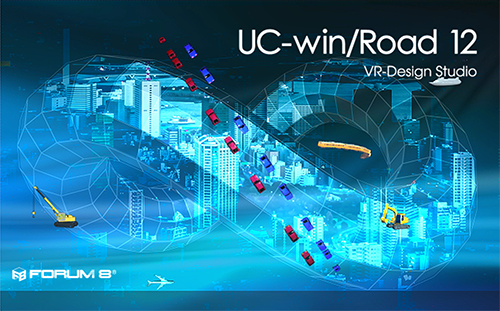
FORUM8 Co., Ltd.
Applications
- 3D Virtual Reality Software “UC-win/Road”
- Civil engineering/construction design
Formats Outils utilisés
 Delphi
Delphi
Défis
Migration of 32-bit applications into 64-bit applications
Résultats
- With Delphi, improved productivity and facilitated division of work in a development team.
- Dramatically reduced time to market by leveraging existing components and frameworks.
Having achieved Development productivity higher than expected with Delphi 10.1 Berlin’s rich libraries, FORUM8 now offers a 64-bit version of its large-scale 3D VR software “UC-win/Road”.

“Delphi has robust libraries and we used Delphi’s components in developing the UC-win/Road in the first place. We just set for ’64-bit’ when compiling. That’s all we needed for 64-bit applications. This dramatically reduced our time to market.”
- Yoann Pencreach, FORUM8 Co., Ltd.
Today FORUM8 Co., Ltd. offers a 64-bit version of “UC-win/Road” to meet the needs of its customers in civil engineering and other industries.
In 2000, FORUM8 released UC-win/Road ahead of others in the industry. UC-win/Road is a general-purpose VR application that helps generate a large-scale 3D VR easily and quickly. Since the beginning, the software has been developed with Delphi. In the latest version for building native 64-bit applications, Delphi’s components and language features contributed to the company having dramatically reduced time to market.
The UC-win/Road software has been widely used for simulation/modeling since VR technology was introduced in the civil engineering/construction industry. Over years, 3D simulation has become larger-scale, with higher needs for larger capacity for scanning/importing measurement data. For the earlier versions of the UC-win/Road, programmed for calculating operations on 32-bit systems, it was challenging to run a one-time simulation of an entire landscape of interest because it required scanning/importing large point clouds to generate a coordinate system of point cloud data. Alternatively, they had to execute a simulation in parts.
Now, the new 64-bit version offers a wider grid of 400 x 200 km instead of 20 x 20 km for long-distance road transport simulations, a visualization of analytical results of tsunami, flood, wind, noise effects, etc. for a longer duration, extensive geolocation, improved analytical capabilities as well as more lay-out models, and high-quality texture and functionality for 4GB or greater memory models, thereby displaying larger-scaled 3D space without difficulty. As a result, the higher processing speed and reduced workloads for both engineers and users have enabled the company to focus resources on key areas.
Yoann Pencreach (Executive Director/Chief Manager of the VR Development Group, FORUM8) recognizes the advantages of employing Delphi 10.1 Berlin for building native 64-bit applications. The company has been using Delphi since their initial 3D software development project:
“Writing in the easy-to-see Delphi code, we have been enjoying high IDE productivity by efficiently dividing development tasks among a few team members. It was amazing for such a small development team to be able to release the initial version in just two years.”
For the 64-bit version project, the company needed to modify the existing source codes built up over years piece by piece in order to change variable declarations and to shift to 64-bit operation from the previous version working on a 32-bit 3D simulation system. According to Yoann, thanks to the Delphi’s components and language features, the development process was significantly accelerated.
“Delphi has robust libraries and we used Delphi’s components in developing the UC-win/Road in the first place. We just set for ’64-bit’ when compiling. That’s all we needed for 64-bit applications. This dramatically reduced our time to market. In the 64-bit UC-win/Road project, we needed to work on our own-developed libraries. Delphi’s clear language syntax allows us to easily search and modify variables and processing steps according to the requirements for 64-bit applications. “
FORUM8 has been leading the industry in 3D simulation for civil engineering, offering unique solutions with VR-based tools such as a variety of simulation and visualization. The company showcase exhibits various VR solutions available for hands-on experience.

Executive Director/Chief Manager of the VR Development Group
Yoann Pencreach
One of examples is a driving simulator on which a visitor can virtually experience driving a car. This simulation system works as a cluster system connected with a network of multiple computers, which enables multiple display devices to synchronize and display images generated on the corresponding computers with little delay. By using Delphi for these cutting-edge technology projects, the company has been successfully accelerating the process of development.

The company showcase exhibits various VR solutions available for hands-on experience. One of the examples is a driving simulator in which a visitor can virtually experience driving a car.
Recently, VR and 3D simulation have been extensively used in industrial applications, ranging from amusement/driving skill training and vehicle development to academic research on road transport. In addition to running simulations on hi-spec machines, it is also necessary to efficiently develop systems for a variety of OS/devices that can easily connect and interact with tablet terminals/smartphones in the field or allow IoT devices to collect and manage data.
Yoann adds, “We are planning to build applications that are not only for PC platforms but also smartphone, tablet, iOS, Android and other devices for use on civil engineering and construction sites. We have added SILS simulation control and cluster synchronization methods to our list of features/functions of research-purpose driving simulators. Our scope of target markets is expanding from automobile/manufacturing industry, education, entertainment, healthcare and so on.“
With Delphi’s support of a highly productive language and IDE, the UC-win/Road software will keep evolving to satisfy ever-expanding applications and customer needs.
